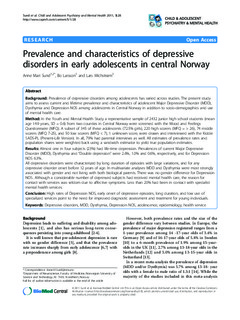| dc.description.abstract | Background: Prevalence of depressive disorders among adolescents has varied across studies. The present study
aims to assess current and lifetime prevalence and characteristics of adolescent Major Depressive Disorder (MDD),
Dysthymia and Depression NOS among adolescents in Central Norway in addition to socio-demographics and use
of mental health care.
Method: In the Youth and Mental Health Study a representative sample of 2432 junior high school students (mean
age 14.9 years, SD = 0.6) from two counties in Central Norway were screened with the Mood and Feelings
Questionnaire (MFQ). A subset of 345 of these adolescents (72.5% girls), 220 high scorers (MFQ = > 26), 74 middle
scorers (MFQ 7-25), and 50 low scorers (MFQ < 7), 1 unknown score, were drawn and interviewed with the Kiddie
SADS-PL (Present-Life Version). In all, 79% had parental interviews as well. All estimates of prevalence rates and
population shares were weighted back using a sandwich estimator to yield true population estimates.
Results: Almost one in four subjects (23%) had life-time depression. Prevalences of current Major Depressive
Disorder (MDD), Dysthymia and “Double depression” were 2.6%, 1.0% and 0.6%, respectively, and for Depression
NOS 6.3%.
All depressive disorders were characterized by long duration of episodes with large variations, and for any
depressive disorder onset before 12 years of age. In multivariate analyses MDD and Dysthymia were most strongly
associated with gender and not living with both biological parents. There was no gender difference for Depression
NOS. Although a considerable number of depressed subjects had received mental health care, the reason for
contact with services was seldom due to affective symptoms. Less than 20% had been in contact with specialist
mental health services.
Conclusion: High rates of Depression NOS, early onset of depressive episodes, long duration, and low use of
specialized services point to the need for improved diagnostic assessment and treatment for young individuals. | nb_NO |
